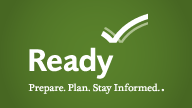 Emergencies can range from the inconvenient to the devastating. Families and businesses can take some simple preparedness steps in advance to minimize the impact on our communities. The Kentucky Office of Homeland Security is working with Ready.gov to ensure that families, businesses, schoolchildren, special-needs and vulnerable populations have the resources they need to be prepared for the unexpected.
Emergencies can range from the inconvenient to the devastating. Families and businesses can take some simple preparedness steps in advance to minimize the impact on our communities. The Kentucky Office of Homeland Security is working with Ready.gov to ensure that families, businesses, schoolchildren, special-needs and vulnerable populations have the resources they need to be prepared for the unexpected.
Be prepared for Natural and Man-Made Disasters
Make a Plan
Emergencies can range from the inconvenient to the devastating, but you can take some simple preparedness steps in advance to minimize the impact on your family.
Inquire about emergency plans at places where your family spends time: work, daycare, and school. If no plans exist, consider volunteering to help create one.
Talk to your neighbors about how you can work together in the event of an emergency. You will be better prepared to safely reunite your family and loved ones during an emergency if you think ahead and communicate with others in advance.
Sometimes there are situations when you should stay put and create a barrier between yourself and potentially dangerous contaminants. This is a process known as shelter-in-place.
Build a Kit
After a disaster, local officials and relief workers will be on the scene, but they cannot reach everyone immediately. You could get help in hours, or it may take days.
Basic services, such as electricity, gas, water, sewage treatment, and telephones, may be cut off for days or even weeks. You may have to evacuate at a moment’s notice and take essentials with you. You probably will not have the opportunity to shop or search for the supplies you will need following a disaster.
A supply kit can help your family stay safe and be more comfortable after a disaster.
You should consider making two kits — one for when you stay in your shelter-in-place and the other a lightweight, smaller version when you have to get away quickly.
Recommended Supplies to Include
- Water - one gallon per person per day, for drinking and sanitation
- Food - at least three-day supply of non-perishable food
- Battery-powered or hand-cranked radio
- Flashlight - and extra batteries
- First-aid kit
- Whistle - to signal help
- Filter mask - or cotton T-shirt, to help filter the air
- Moist towelettes - for sanitation
- Wrench or pliers - to turn off utilities
- Manual can opener - for food (if kit contains canned food)
- Plastic sheeting and duct tape - for shelter-in-place
- Garbage bags and plastic ties - for personal items
- Unique family needs - such as prescription medications, infant formula or diapers, and important family documents
- Pet food - and extra water for your pet
- Personal documents - in waterproof container
Communications Plan
Choose two places to meet: right outside your home in case of a sudden emergency and outside your neighborhood if you can’t return home.
Pick a family contact in another state who everyone can contact if separated in an emergency.
Remember that cellular towers and the telephone system may not work immediately following an emergency. Deciding who will pick up the kids and where to meet are questions that need to be addressed before a disaster strikes.
Download our "Developing a Plan and Kit to Protect Your Family Brochure".